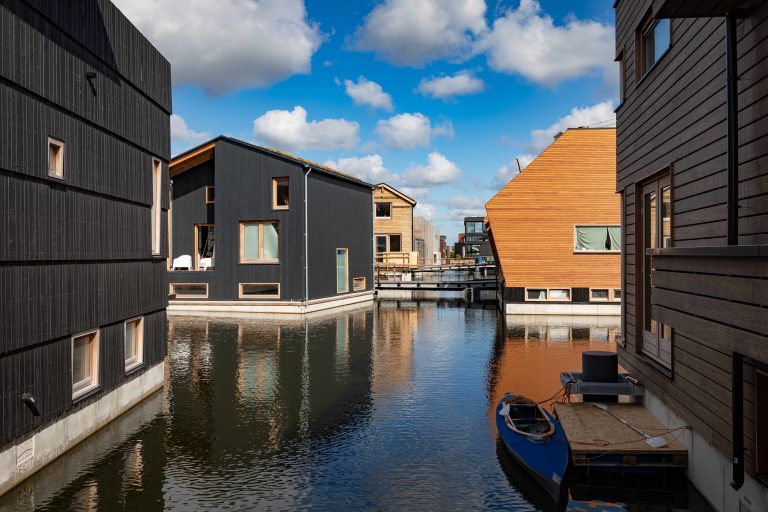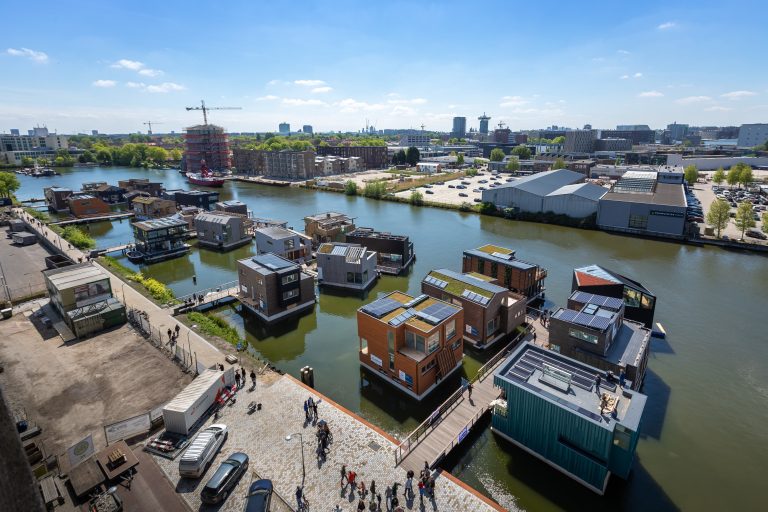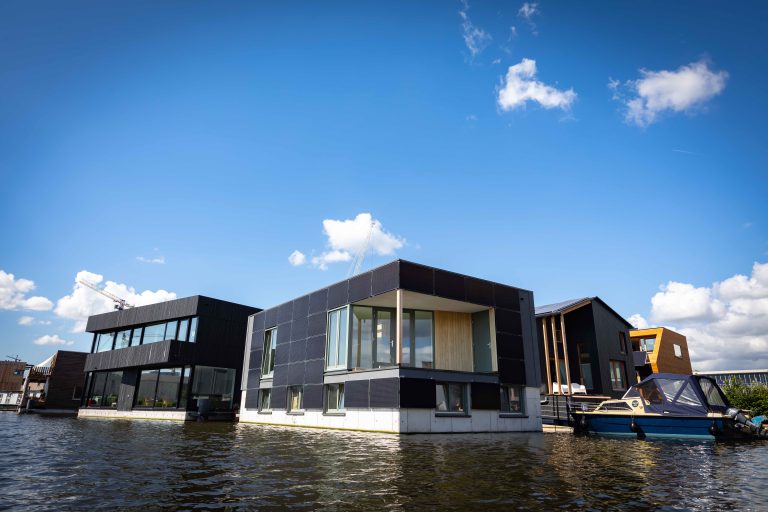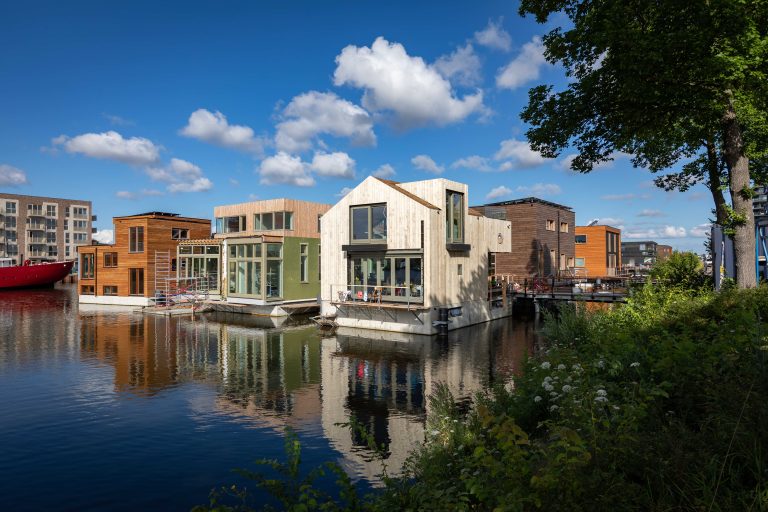
The context
Article written by Mary Sarsam
Following over a decade of dreaming, planning, applying for subsidies and grants, and envisioning the project from start to finish, Schoonschip welcomed its first residents in 2019 Located in Buiksloterham in the northern part of Amsterdam, this floating housing community is unique in its focus on sustainable construction, urban agriculture, and community design. Initiated by Marjan de Blok and Thomas Sykora, Schoonschip now accommodates 144 people across 46 households. In addition to shared infrastructure, the community includes a collective space where residents can gather and connect.
With 516 solar panels, 30 heat pumps and 60 thermal panels, Schoonschip has established an energy-independent and interdependent living community that is not connected to Amsterdam’s gas system. They meet nearly all their energy needs through an internal smart grid, which allows for energy exchange between homes. However, they still maintain a connection to the national energy grid as they require additional energy in the winter and have a surplus to share in the summer. In this article, we will give you an overview of this unique living community by looking at the history and establishment of Schoonschip as well as their current ways of living.
How the energy community was formed
Schoonschip was established with the goal of creating an innovative, self-sufficient energy system for an entire floating neighborhood, guided by the core value of minimizing its environmental impact. The project was founded on a strong, unified vision of community collaboration. To support community-driven decision-making, the residents formed a working board and created task forces to focus on key topics such as mobility, the smart grid, and food.
In 2008, Marjan de Blok connected with Pauline Westendorp, then manager of the GeWoonboot, over their shared vision of self-sufficient living on water. That same day, they joined forces with Thomas Sykora, and together they conceived the idea for a collective citizen initiative, jotting down their initial ideas on an A4 sheet of paper.
Over the next decade, the project went through multiple phases. They secured a subsidy, which enabled them to hire a consultancy firm, and obtained their first loan. After selecting a location at the Johan van Hasselt Canal in Buiksloterham, they conducted feasibility studies, developed manifestos, and built a strong community of dedicated supporters.
By May 2016, Gridfriends—a Dutch/German energy consortium—was awarded a European grant for a research project that set a new standard in smart grid technology, which was implemented at Schoonschip. A year later, permits for the construction of the floating homes were approved. By 2018, the first arks arrived in the area, and in January 2020, the final arks were delivered. After more than a decade in development, Schoonschip was finally completed, and the community has since been able to live their day to day lives in this unique place.
Designed to float
Schoonschip’s location on a canal in the northern part of Amsterdam highlights the community’s deep connection to water and ecological sustainability. With a focus on water conservation and improving the canal’s water quality, water stewardship is central to Schoonschip’s framework. Several environmentally conscious initiatives have been implemented within the collective, including sedum roofs, natural water sources, water-efficient facilities, and wastewater utilization. Additionally, Schoonschip’s floating gardens and riverside park management have expanded local wildlife habitats, supporting birdlife and improving water ecology.

Design features
Sedum Roofs
Sedum roofs consist of a thin substrate layer that supports grasses, succulents, mosses, and other plants. These roofs slow rainwater drainage and help absorb dust and reduce noise. At Schoonschip, sedum roofs are paired with solar panels, which benefit from the natural cooling effect of the plants, optimizing panel efficiency.
Natural Water Sources
Some houseboats are equipped with water tanks that collect rainwater, which is then used to water plants. However, water from the Johan van Hasselt Canal—where the houseboats are docked—cannot be used because it connects to the sea. The higher salinity of the water would corrode the pipes, making it unsuitable for community use.
Water-Efficient Facilities
Many Schoonschip residents have installed recirculation showers, which reuse water multiple times through an integrated cleaning system. These showers can save up to 90% of water and reduce energy consumption by about 80%. Additionally, all homes have vacuum toilets that use just 1.5 liters of water per flush, compared to older models that use 5 to 7 liters.
Wastewater Utilization
Schoonschip has introduced infrastructure to separate wastewater into black water (toilet/human waste) and grey water (from kitchens, showers, washing machines, and dishwashers). Grey water is drained through the municipal sewer system, while black water is part of an innovative trial with Waternet, the regional water supplier. Within this system toilets are connected to a floating processor that distills biogas from the black water, which can be converted into electricity for homes or used as vehicle fuel. Waternet would also extract phosphate—a rare fertilizer typically produced through environmentally harmful methods—from the black water, promoting a circular production model. The processing plant has been built, but unfortunately Waternet has not yet put it into operation. The reason for this is legal and bureaucratic, but they want to go ahead with it in the future.

Building Materials
Schoonschip aimed to source materials for its houseboats exclusively from certified suppliers to ensure a positive impact on the supply chain and reduce the risk of unethical or environmentally harmful practices. The community also applied circular economy principles and prioritized sourcing local materials whenever possible.
Smart Grid
One of Schoonschip’s standout innovations is its smart grid—a decentralized energy system that allows households to generate, share, and distribute energy. The community partnered with Spectral, a Dutch smart energy solutions company, and other energy experts to design and implement this grid.
Through the smart grid, the entire community shares a single connection to the grid operator, enabling them to generate, exchange, and pay for energy as a collective. Ideally, the community produces most of its energy needs, distributes it through the smart grid, and stores any excess in batteries.
Operating a separate energy network is a rare privilege, granted by the Ministry of Economics and Climate to allow for experimentation and innovation. Schoonschip was formally exempted from working with existing energy suppliers, giving the community full control over how they manage their energy system.
Governance
Community involvement was essential to both the founding process of Schoonschip and the ongoing life of its residents. Decisions are made democratically, ensuring that all voices within the community are heard and considered. All residents are members of an owners’ association, with working groups dedicated to specific areas such as sanitation, energy, shared mobility, ecology, water quality, and communication. A party committee fosters social cohesion through community meetings and events.
Schoonschip’s legal structure is composed of multiple entities—including a corporation, cooperative association, owners’ association, and pioneering vessel—reflecting the complex and innovative organizational framework required to address situations beyond conventional norms.
Funding and Support
In terms of financing, Schoonschip emphasized the considerable risks members took to bring the project to life. This collective development project aimed to be affordable and advocated for more housing units than initially proposed by the Amsterdam council to accommodate residents across a range of income levels.
The community maintained a transparent collective budget from the outset, covering shared infrastructure such as the energy grid, plumbing, and jetties. This transparency allowed future houseboat owners to clearly understand their costs beyond constructing their individual homes.
Schoonschip’s legal structure is composed of multiple entities—including a corporation, cooperative association, owners’ association, and pioneering vessel—reflecting the complex and innovative organizational framework required to address situations beyond conventional norms.
Lessons learned
Schoonschip has frequently acknowledged that the project was far more complex to realize than initially anticipated. While they originally aimed to provide housing for people with limited means, this goal ultimately proved unachievable. The initial vision was to offer affordable housing for households of all backgrounds, spanning five different income categories. However, after numerous meetings with housing corporations, they recognized that creating social housing was beyond their financial capacity. As a result, the project only catered to those with the necessary financial resources.
The community also reflected on their individualistic approach, which they believe contributed to the project’s ten challenging years of implementation and led to the use of less sustainable materials in the construction of the homes. Since multiple project developers were involved in building the individual houses, there was no cohesive approach to construction. Instead, the project became a collection of privately developed homes, with residents selecting their own architects and contractors.
To manage shared aspects of the development—such as the jetty—a corporation was established, bringing together future residents and an external advisor. Significant resources were spent balancing personal preferences with the collective’s environmental goals, and the group lacked sufficient expertise in project development.


Looking forward
Schoonschip represents a bold and innovative approach to sustainable living, where community collaboration and environmental stewardship come together to create a thriving, energy-independent neighborhood. Despite facing challenges and complexities along the way, such as financial constraints and a highly individualized approach to construction, Schoonschip has successfully demonstrated the potential of self-sufficient, eco-friendly living. From its smart grid system to water conservation efforts and sustainable materials, the community serves as a model for future urban developments. As the residents of Schoonschip continue to live and grow together, their collective journey highlights the importance of adaptability, transparency, and shared values in building a more sustainable and harmonious way of life.
